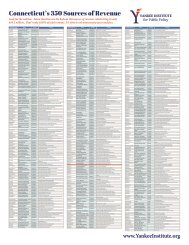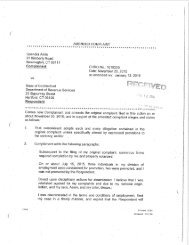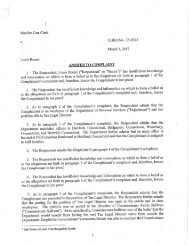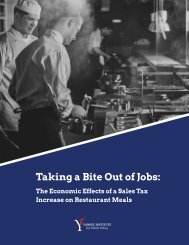Connecticut's Top Ten Business-Friendly Towns
Find out which Connecticut towns are truly open for business!
Find out which Connecticut towns are truly open for business!
You also want an ePaper? Increase the reach of your titles
YUMPU automatically turns print PDFs into web optimized ePapers that Google loves.
Community allure 35%<br />
In the context of this report, “community allure” does not refer to the local charms and ambiance that make<br />
our favorite places special – such as an appreciation of Long Island Sound or a taste for New Haven-style<br />
pizza. Here, we use the term exclusively to refer to factors that draw businesses to an area and keep them there<br />
once they’ve established themselves. An educated population, low rates of crime and a low cost of living are<br />
particularly likely to foster entrepreneurship and attract expansion or relocation of existing businesses.<br />
Education is a strong signal for human capital, which is vital in today’s tech- and information-driven economy.<br />
And not just education in the broad sense: the type and extent of education matter as well. With the data<br />
available to our research team, we focused on the extent of the local population with educational attainment<br />
in two specific categories. The first category captures the educational achievements of young members of the<br />
community in the form of average SAT scores earned by residents. The second category captures older, more<br />
established workers (aged 25 and older) who have earned at least an associates’ degree. The first of these inputs<br />
carries a one-quarter weight in the community allure assessment; the latter carries 30 percent.<br />
Crime, and particularly violent crime, can have a negative impact on the allure of a community. Connecticut is<br />
a low-crime state, ranking 9th lowest in property crimes and 5th lowest in violent crimes nationally in 2016.1<br />
Statewide figures, though, hide the distribution of crime rates throughout the state. These vary widely, ranging<br />
from Hartford’s high of 1,058.7 violent crimes per 100,000 residents to lows of no violent crime whatsoever<br />
in several small, rural towns. And crime can matter in more than absolute terms; sometimes relatively small<br />
variations between towns with relatively low absolute crime can create the impression that the towns with mildly<br />
higher crime rates suffer significantly more crime. For these reasons, we include violent crimes, the most salient<br />
and attention-grabbing type of crime, in our index and weight it at 30 percent of the community allure category.<br />
Finally, we consider cost of living. In this study, we measure cost of living using a proxy measurement, the<br />
median home value in a locale. We would ideally have used a more direct measure, such as real purchasing<br />
power as defined by the Bureau of Economic Analysis.2 The way municipalities are aggregated by metro areas<br />
and non-metro areas in that data set, though, erases important differences between municipalities that were<br />
vital to our analysis in this study. (This anomaly in the data set is particularly relevant to Connecticut, where our<br />
suburbs have an extremely wide range of costs of living.) Cost of living thus measured bears 15 percent of the<br />
weight in the community allure category.<br />
Economic vitality 35%<br />
<strong>Business</strong>es care greatly about the prospect of future growth in a region when they weigh decisions such as<br />
opening, moving or expanding. While there are no crystal balls for economic growth, past performance tends<br />
to predict future performance and thus businesses look for trends in historic data in evaluating a community’s<br />
vitality.<br />
We have undertaken that analysis in this study. Our economic vitality category considers median household<br />
income and three-year population and job growth using five-year American Citizen Survey (ACS) data. These<br />
inputs give us a sense of both how affluent a municipality is and in what direction it has trended in the past three<br />
years relative to its peers.<br />
1 https://www.usnews.com/news/best-states/rankings/crime-and-corrections/public-safety<br />
2 https://taxfoundation.org/real-value-100-metro-2017/







